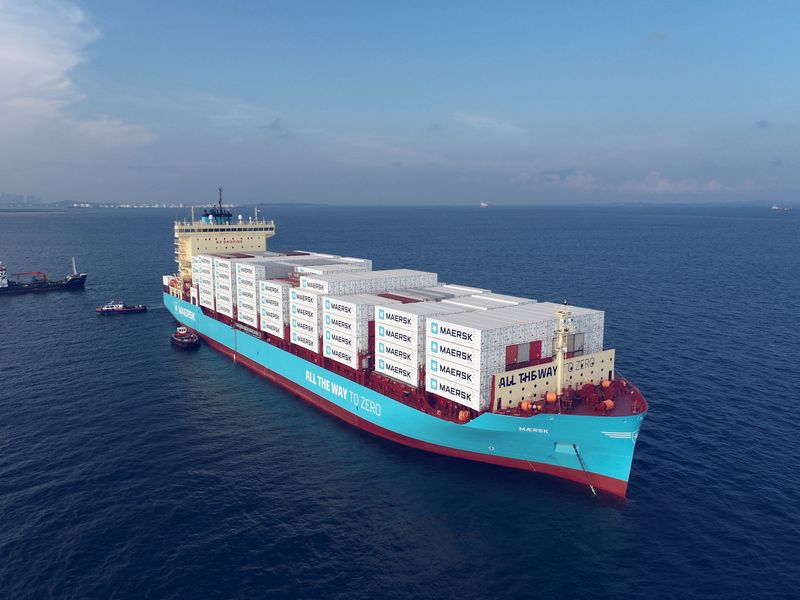By Jeslyn Lerh and Jacob Gronholt-Pedersen
SINGAPORE/COPENHAGEN (Reuters) -Container shippers are ordering vessels powered by methanol to reduce greenhouse gas emissions, but it will take years for renewable methanol output to meet demand and for costs to fall, industry executives said.
The first green methanol-fuelled container ship, owned by A.P. Moller-Maersk, sailed from South Korea in July. The number of such vessels is expected to exceed 200 by 2028, up from 30 this year, consultancy DNV forecasts.
Container giants such as A.P. Moller-Maersk, CMA CGM and XpressFeeders dominate the order books. They ship consumer goods for companies including Apple (NASDAQ:AAPL), Nike (NYSE:NKE), Adidas (ETR:ADSGN) and Walmart (NYSE:WMT) and are betting on methanol, as well as exploring other less developed options such as ammonia, to meet their own and clients' emission reduction targets.
Maersk said methanol-powered ships with dual-fuel options cost about 10%-12% more than conventional ships, but the price difference should become insignificant in the longer run once developers achieve economies of scale.
The challenges of delivering enough fuel, however, are considerable and emissions will not be entirely eliminated.
"The real cost challenge remains on the fuel supply side and the need to rapidly build production globally and at scale; and the associated fuel infrastructure," Emma Mazhari, Maersk's head of energy markets, told Reuters.
Conventional methanol emits up to 80% less nitrogen oxides and cuts nearly 99% of sulphur oxide emissions versus fuel oil, but it still emits planet-warming carbon dioxide.
Using methanol, produced either from biomass or captured carbon and hydrogen from renewable power, can reduce carbon dioxide emissions from container ships by 60% to 95% compared with conventional fuels, the Methanol Institute said.
But green methanol, produced from biomass or captured carbon and hydrogen from renewable power, is scarce and costs at least twice as much as conventional methanol, produced from fossil fuel, industry insiders say.
The renewable fuel's production is also far from the bunkering hubs, where ships refuel, meaning additional costs in terms of money and emissions for transportation, they added.
"It still has a 'C' (carbon) in its formula so the fuel that remains is not zero carbon," said Rashpal Singh Bhatti, BHP's vice president for maritime and supply chain excellence, referring to conventional methanol.
He added using methanol produced using fossil fuel was pointless in terms of reducing emissions.
"Ultimately, we're trying to find the ubiquitous source that has good decarbonisation potential," he said.
Global demand for methanol, typically used in construction and manufacturing, stands at 100 million tonnes per year (tpy), while a 16,000-TEU container ship consumes 30,000 to 40,000 tpy, the Methanol Institute said.
Methanol demand could grow by a further 6-to-8 million tonnes per year in 2028, based on Reuters calculations and the vessels on order.
However, bio-methanol provides less than 1% of global production, at between 300,000 and 400,000 tonnes as of last year, according to the Methanol Institute, which means ships for now must rely mainly on more conventional fuels.
"The main issue with methanol at this stage is increasing access and the scale of green production," Peter Lye, global head of shipping at Anglo American (LON:AAL), said. He said the company was monitoring progress but had yet to place an order for such ships.
LOCATIONS
Shippers hope that their investments in methanol-fuelled ships will spur production of the renewable fuel and lower costs in the long run.
"We are tracking more than 90 projects globally looking to produce bio-methanol or e-methanol, with total announced anticipated production capacity of 8 million tonnes by 2027," the Methanol Institute's CEO Greg Dolan said, adding that the size of the plants being built has grown to 50,000-250,000 tonnes per year from 4,000-10,000 tonnes previously.
Netherlands-based OCI, which supplied green methanol to Maersk's first ship, can produce up to 200,000 tpy of the renewable fuel.
Bashir Lebada, CEO of OCI's methanol and fuels business, said the vessel orders have given suppliers a confidence boost in advancing their green methanol projects even though production is "very small" now.
Most green methanol projects are located in China, northern Europe and North America - far from major bunker hubs Singapore and the United Arab Emirates, creating a logistical gap.
Costs will come down as production increases over the next 15-to-20 years from less than 1% of output now, said Anita Gajadhar, Proman's executive director for marketing, logistics and shipping, adding that more countries, such as Chile and Argentina, have potential to make green methanol.
Within Asia, South Korea and China are set to increase their capacity to fuel ships with green methanol.
"Strategically this makes sense given the available methanol storage volumes and the port's proximity to the major Asian dockyards handling the majority of methanol newbuild orders," said Gajadhar, adding that multiple Chinese ports will also have a sizable demand requirement in future.
Maersk has set itself a goal to use low-emission fuels to transport a quarter of its volumes by 2030.
